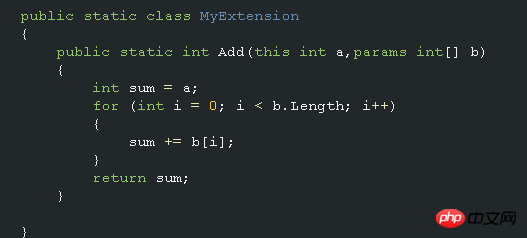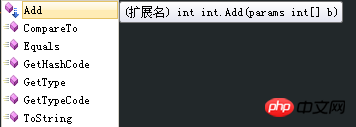Maison >développement back-end >Tutoriel C#.Net >exemple d'introduction à la méthode d'extension c#
exemple d'introduction à la méthode d'extension c#
- 黄舟original
- 2017-03-03 13:35:581360parcourir
C#Méthodes d'extension Exemple de démarrage
Définition de la méthode d'extension :
l doit être une classe statique, méthode statique
l Le premier paramètre contient le mot-clé "this", indiquant à quel type
Description du code : L'exemple ici est d'écrire une classe statique, myExtension, une méthode d'extensionAjouter , indiquant que tous les numéros de type INT auront la possibilité d'appeler cette méthode Add, à condition que MonExtension.

Jetons un coup d'œil à l'utilisation :

Description du code : ce code déclare un numéro de type int et attribue la valeur à 7, et puis lors de l'appel de la méthode Add, vous verrez IntelliSense comme suit :
Vous pouvez voir que la méthode d'extension est marquée par une flèche vers le bas. Ensuite, appelez-le, donnez-lui n'importe quel  int, puisque j'ai utilisé le mot-clé params, il sera automatiquement analysé en Tableau int, puis utilisez la variable rlt pour le recevoir, et une fois affiché, vous verrez le résultat :
int, puisque j'ai utilisé le mot-clé params, il sera automatiquement analysé en Tableau int, puis utilisez la variable rlt pour le recevoir, et une fois affiché, vous verrez le résultat :

Écrit une méthode pour étendre la chaîne, qui peut normaliser l'anglais. Par exemple, hEllo et WORld seront affichés une fois transmis, Hello World Utiliser :using System;
using System.Collections.Generic;
using System.Linq;
using System.Text;
namespace wpfLab1
{
public static class StrExtensenClass
{
public static string GetNormalFormat(this string s)
{
s = RemoveExtraSpace(s);
string[] words = s.Split(' ');
string ret = "";
foreach (var word in words)
{
ret += StrFstChrUpr(word) + " ";
}
return ret;
}
public static string RemoveExtraSpace(this string s)
{
if (s == null || s.Length <= 1)
{
return s;
}
bool lastChrIsSpace = false;
string ret = "";
foreach (var chr in s)
{
if (chr == ' ')
{
if (lastChrIsSpace)
{
continue;
}
else
{
lastChrIsSpace = true;
ret += chr;
}
}
else
{
ret += chr;
lastChrIsSpace = false;
}
}
return ret;
}
private static string StrFstChrUpr(string s)
{
if (s == null || s.Length < 1)
{
return s;
}
string lowerStr = s.ToLower().Remove(0, 1);
string upperStr = Char.ToUpper(s[0]).ToString();
return (upperStr + lowerStr);
}
}
}using System;
using System.Collections.Generic;
using System.Linq;
using System.Text;
using System.Windows;
using System.Windows.Controls;
using System.Windows.Data;
using System.Windows.Documents;
using System.Windows.Input;
using System.Windows.Media;
using System.Windows.Media.Imaging;
using System.Windows.Navigation;
using System.Windows.Shapes;
using wpfLab1;
namespace wpfLab1
{
/// <summary>
/// MainWindow.xaml 的交互逻辑
/// </summary>
public partial class MainWindow : Window
{
public MainWindow()
{
InitializeComponent();
}
private void btnHello_Click(object sender, RoutedEventArgs e)
{
string s = "hEllo wOrLd, hi, world , aa dd dw WWdd a ";
lblHello.Content = s.GetNormalFormat();
}
}
} Ce qui précède est le contenu de l'exemple d'introduction à la méthode d'extension c#. Pour plus de contenu connexe, veuillez faire attention au site Web PHP chinois (www.php.cn) !

